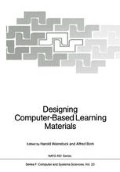Abstract
Computer programs to aid learning, in which the aim is not to emulate a teacher carrying on a tutorial dialogue, can very commonly be classified as either simulation or modelling programs. For the purposes of this paper the difference is this:
-
in a simulation program, the principles to be learned are encoded within the software. The user’s aim is typically to “discover” the rules by some kind of scientific investigation or to acquire a gut feeling for how the encoded principles control various situations. For example, in a program (developed at the University of California, Irvine) that simulates planetary motion, the user sees a plane view of the path of a planet about a sun. He or she can shrink or enlarge the view, change the initial location and Velocity of the planet, change the masses of the planet and sun, and even change the exponent of the law of force. If users make good use of this program, they can “discover” the elliptical paths associated with an inverse square law of force, the concept of “escape velocity” and the unstable or non-periodic paths associated with some other laws of force.
-
in a modelling program, the user builds a simulation, and then either uses it to see if his understanding agrees with what “ought to happen” or uses it to acquire the kind of gut feelings mentioned above.
Access this chapter
Tax calculation will be finalised at checkout
Purchases are for personal use only
Preview
Unable to display preview. Download preview PDF.
References
Anderson, J.R. (ed), Cognitive Skills and Their Acquisition, Lawrence Erlbaum, 1981.
Anthony, W.S., “Learning to discover rules by discovery,” Journal of Educational Psychology, 64, 325–8, 1973.
Boden, M., Piaget, Fontana, 1979.
Case, R., “General developmental influences on the acquisition of elementary concepts and algorithms in arithmetic,” in Carpenter, Moser and Rombey (eds). Addition And Subtraction: A Cognitive Perspective, Lawrence Erlbaum, 1982.
Chung, P., “Concurrent-LOGO: a language for teaching control applications,” DAI Research paper no. 243, Dept. of AI, Edinburgh 1984.
Chung, P., in Robotics in Education, ed. Colin Terry, Croom Helm, 1985 (to appear).
diSessa, A., “A Principled Design for an Integrated Computational Environment,: MIT AI Memo ?? 1982.
du Boulay, J.B.H., “Teaching teachers mathematics through programming” International Journal of Math Education in Science and Technology, 11 (3), 347–360, 1982.
Edinburgh LOGO Group, “Teaching Mathematics Through LOGO Programming: Teacher’s Notes and Example Pupil Worksheets,” DAI Occasional Paper Nos. 38–41, Dept. of AI, Edinburgh, 1984.
Gentner, D. and Stevens, A. (eds), Mental Models, Lawrence Erlbaum, 1982.
Hewitt, C., “An Artificial Intelligence Perspective,” in Brody et al (eds.), On Conceptual Modelling, Springer-Verlag 1984.
Hinton, T., Computer Education, 2, 71–88, 1978.
Howe, J.A.M., Ross, P.M., Johnson, K.R., Plane, F and Inglis, R., “Learning Mathematics through LOGO Programming: the transition from laboratory to classroom,” DAI working paper 118(b), Dept. of AI, University of Edinburgh, 1982.
Kurland, D.M. and Pea, R.D., “Children’s mental models of recursive LOGO programs,” Technical Report No. 10, New York: Center for Children and Technology, Bank Street College of Education, 1983.
Pascual-Leone, J., “A mathematical model for the transition rule in Piaget’s developmental stages,” Acta Psychologica 32, 301–345, 1970.
Pea, R.D. and Kurland, D.M., “Logo programming and the development of planning skills,” Technical Report No. 16, New York: Center for Children and Technology, Bank Street College of Education, 1983.
Scandura, J.M., et al, “An unexpected relationship between failure and subsequent mathematics learning,” Educational Studies in Mathematics 1, 247–151, 1969.
Schools Committee Working Party, “Syllabuses for the future,” London: British Computer Society, 1980.
Tawney, D.A., Simulation and Modelling in Science Computer Assisted Learning, C.E.T., London, 1976.
Teitelbaum, T. and Reps, T., “The Cornell Program Synthesizer: A Syntax Directed Programming Environment,” Dept. of Computer Science Technical Report TR 80–421, Cornell University, 1980.
Trown, E.A., “Some evidence on the interaction between teaching strategy and personality,” British Journal of Educational Psychology, 40, 209–211, 1970.
Trown, E.A. and Leith, G.O.M., “Decision rules for teaching strategies in primary schools: Personality–treatment interactions,” British Journal of Educational Psychology, 45, 130–140, 1975.
Author information
Authors and Affiliations
Editor information
Editors and Affiliations
Rights and permissions
Copyright information
© 1986 Springer-Verlag Berlin Heidelberg
About this paper
Cite this paper
Ross, P. (1986). Modelling as a Method of Learning Physical Science and Mathematics. In: Weinstock, H., Bork, A. (eds) Designing Computer-Based Learning Materials. NATO ASI Series, vol 23. Springer, Berlin, Heidelberg. https://doi.org/10.1007/978-3-642-82654-2_4
Download citation
DOI: https://doi.org/10.1007/978-3-642-82654-2_4
Publisher Name: Springer, Berlin, Heidelberg
Print ISBN: 978-3-642-82656-6
Online ISBN: 978-3-642-82654-2
eBook Packages: Springer Book Archive

